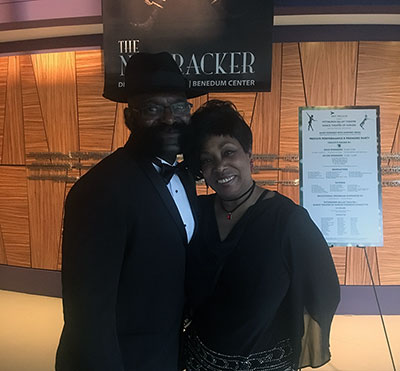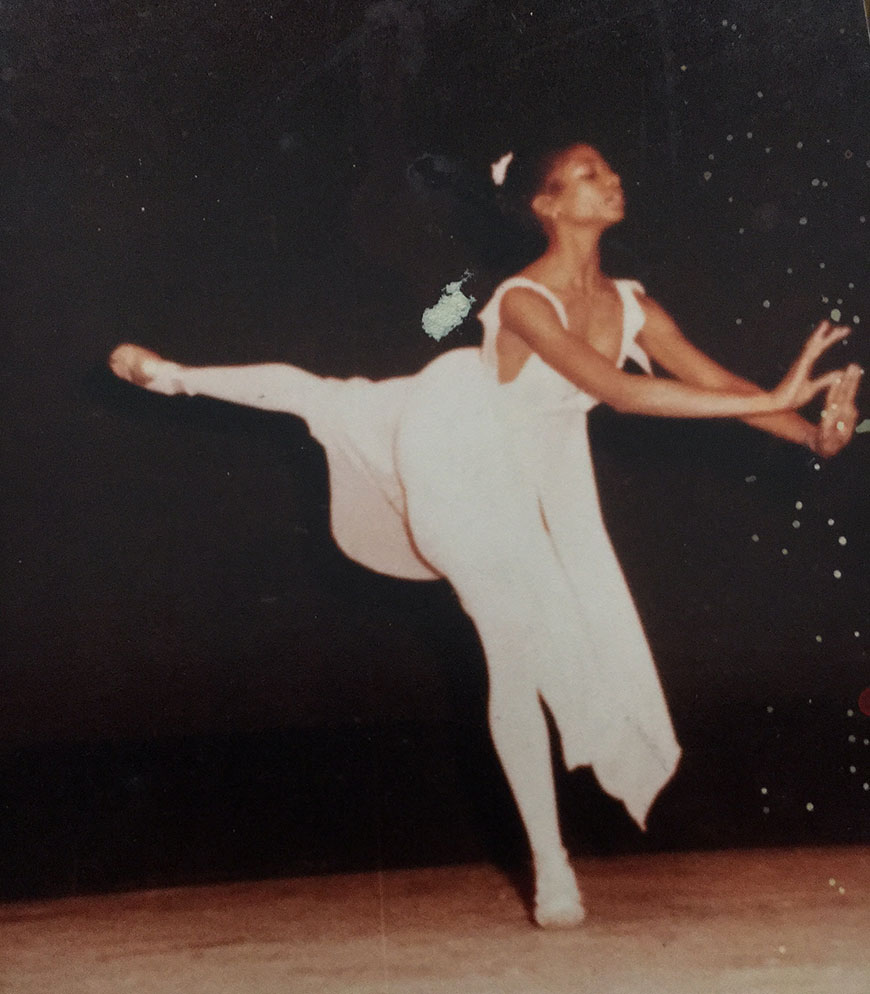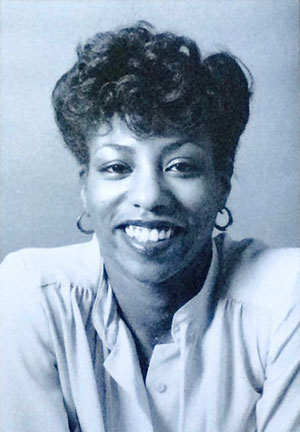#FacesOfBalletPgh: Leslie Anderson-Braswell
Dance faculty member, CAPA; former professional dancer at Pittsburgh Ballet Theatre and Dance Theatre of Harlem
 Leslie Anderson-Braswell says she got serious about ballet in 1969. Fittingly, it’s the founding year for two companies that played defining roles in her journey as a dancer: Pittsburgh Ballet Theatre and Dance Theatre of Harlem.
Leslie Anderson-Braswell says she got serious about ballet in 1969. Fittingly, it’s the founding year for two companies that played defining roles in her journey as a dancer: Pittsburgh Ballet Theatre and Dance Theatre of Harlem.
Her performance career started with a post in Pittsburgh Ballet Theatre’s The Nutcracker, and she never looked back. She went on to become a founding company member of PBT, trained with Dance Theatre of Harlem, and danced overseas with the Stuttgart Ballet school and company. After returning to the states, she also returned to Dance Theatre of Harlem, this time as a company member.
Since retiring from the stage, Anderson-Braswell has shared her love of ballet with a new generation of dancers. She has instructed ballet and pointe at CAPA since 1979, and her teaching credits also include the Pittsburgh CLO Academy, Checcetti Council of Pennsylvania and Dance Masters of America. Each year, in her name, the Pittsburgh dance community honors one exceptional male and female dancer with the “Brazzy Award,” a tribute to her integrity as a teacher and her contributions to her field.
As an African-American artist, ballet has brought Anderson-Braswell both tremendous joy and struggles with acceptance along the way. Now, 38 years after starting in the field, she’s proud to see the art form evolving into a more inclusive medium for artists of all cultures. Here, she shares her experience.
When, where and why did you first get into ballet?
“I started studying ballet seriously, on a daily basis in 1969, when Mr. Petrov, artistic director of the newly forming PBT, put an audition notice in the paper, calling for children to participate in the Nutcracker Ballet, at the Pittsburgh Playhouse. I was cast, with many other local children, and I was a mouse for that season, which included over 20 matinee and evening performances (!), and I fell in love with the “world” of ballet!”

How has it shaped you as a person?
“Ballet quickly became my life….the discipline, the technical challenges, the accomplishments, the dedication, the theater, the choreography, the demands, the sense of self, the history and tradition, the majesty, the royalty, my profound love for the beauty, grace and technical prowess. I am ballet, and ballet is me!”
How would you describe the feeling dance gives you?
“It is very difficult for me to put into words how I feel when I danced; but, there is nothing quite like it that I have experienced in my life. The extraordinary sense of satisfaction, accomplishment and overwhelming joy that dance gave me when I was a practicing dancer; and now, teaching young aspiring dancers the fundamentals of the technique, along with the joy of artistic growth, mastery and freedom, through expression in performances. For me, I was always overwhelmingly happy and elated, every chance I got to be on the stage!”

What was one challenge you had to overcome to pursue ballet to the professional level?
“The one challenge that I had to overcome in pursuit of development, growth and excellence in ballet, during my training years, was being accepted to pursue the profession because I am African American. {In order to overcome this I had} to believe in my destiny, continue working hard and seek excellence in my training. I was encouraged to go to the Stuttgart Ballet in Germany because, generally speaking, it was explained to me that Europe did not look so much at the color of one’s skin as they looked at one’s ability and talent. During that time period in the early ‘70s, it was definitely true! I was able to excel and grow, although even in Stuttgart there were not many African Americans in the company or school. That is why my ultimate goal remained becoming a member of Arthur Mitchell’s Dance Theatre of Harlem. Now, long after my dancing days, I’m overjoyed with the changing face of ballet in America and in the world! Diversity and inclusion abounds!”
What helped you overcome this challenge, and any others, in your life?
“Through my mother’s encouragement that I could do and be anything that I wanted to do and be in life, and my father’s insistence that everything is possible with sacrifice, hard work and perseverance. This family support helped to develop an unbreakable bond and love that there were no challenges too great to overcome.”
How has ballet changed since your days as a professional dancer with Pittsburgh Ballet Theatre and Dance Theatre of Harlem?
“Since my days with PBT (1969-1973), the Stuttgart Ballet School/ Opera Ballet Co. (1973-1975), and DTH (1975-1976), the world of ballet has become much more diverse, and accepting of talent, regardless of the color of one’s skin, globally!”
What excites you about the future of ballet and its possibilities?
“That it has grown so tremendously, accepting diverse talented people, making it possible for Misty Copeland to be named principal at ABT, was something that I did not think would ever happen in ballet in America! I so celebrated this accomplishment, though I am aware of the multitude of talented African-American ballerinas that paved the way for the arrival of Misty! Collectively, many, including myself, felt represented that magnificent day, and we all celebrate Misty with such pride and happiness! With new and innovative choreography, and the superior talents of the dancers, the future of ballet seems very exciting and limitless.”
What advice would you give to a young dancer today? To your younger self?
“My strongest advice to ALL young dancers today is to believe in themselves, sacrifice, be dedicated, work hard, and seek excellence! For my younger self I would definitely say to realize that being on stage will not last forever, so relish each and every moment and opportunity that comes my way!”
Why do you believe dance in general, and ballet in particular, is universal?
“Though most people are unaware of it, dance is universal because, in my opinion, we are ALL born dancers! From the time in our mother’s womb, and we hear music…we dance. When we are born, and very early in life, as we are held, as babies, we respond to the sound of music, beats, rhythms. As soon as we are crawling, we respond to music, in many different ways. When we are learning to walk, we respond to music. At all times in life, music is universal, and so is dance! Ballet has come, through every period of history for the past 500 years, of royal lineage. It is my belief that regardless of your ancestry, we relate to royalty, and everyone can relate to being a king or a queen, a prince or a princess! Now, ballet represents such unbelievable athleticism, physical skill and superior mastery of those skills! For me, ballet has always been universal; as universal as all sports!”
What does it mean for you to be able to pass on your love for ballet to other dancers? Over the course of your teaching career, what stands out in your mind?
“Greer Reed was my first student to follow in my footsteps, and I mentored her through her illustrious career at Alvin Ailey II and later, rising to principal roles as she danced in works by prominent African-American choreographers at Dayton Contemporary Dance Company. Now, she is a leader in every sense of the word, in our dance community and as she continues to honor dance in the African-American tradition. The award that she gives in my name every year to an outstanding, passionate artist, is such a great honor!
Secondly, Ayisha Morgan-Lee, who also sits on the PBT+DTH steering committee, was my student at CLO from the age of 10! Again, she told me that I was an inspiration to her, the first African woman she ever met that taught ballet, which she loved deeply! You know that she majored in dance at Howard University, interned at Alvin Ailey American Dance Theater, received her Masters in Arts Management from CMU, opened her own school over ten years ago and now she, like Greer, employs me! I can’t explain how overjoyed and proud they, along with so, so many others make me feel every day of my life!”
Why is the Pittsburgh Ballet Theatre and Dance Theatre of Harlem collaboration important to you personally, and why do you think it’s important for our community?
“It is a fulfillment of my dreams come true….truly bringing my life full-circle! Back in 1975, arriving at DTH, I remember going to our tour manager to ask if we would be touring to Pittsburgh. I remember my sadness when he told me the closest we’d be in Pennsylvania would be Philadelphia. I was sad because my family had not seen me dance since I left PBT in 1973! So, this collaboration is so full-circle for me and although my mom has passed on and my dad is in failing health, I’m so thankful and grateful to them for giving me the opportunity to follow and live my dreams! For our community, this collaboration represents the beginning of acknowledging the greatness and excellence of ballet in Pittsburgh coming together with that from Harlem and New York City. And it means acknowledging that ballet is colorless, without boundaries and that the future is limitless for where it can go! For me, that’s so very promising and exciting!”
